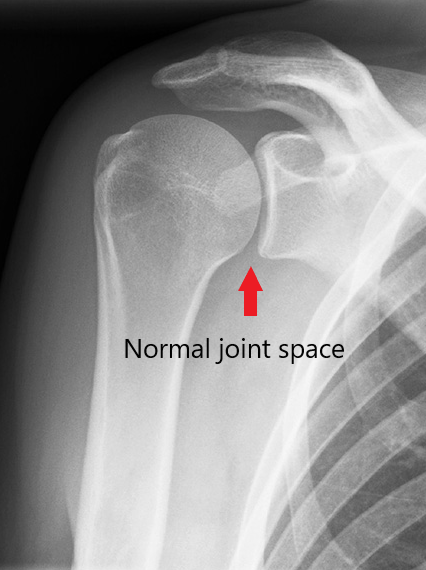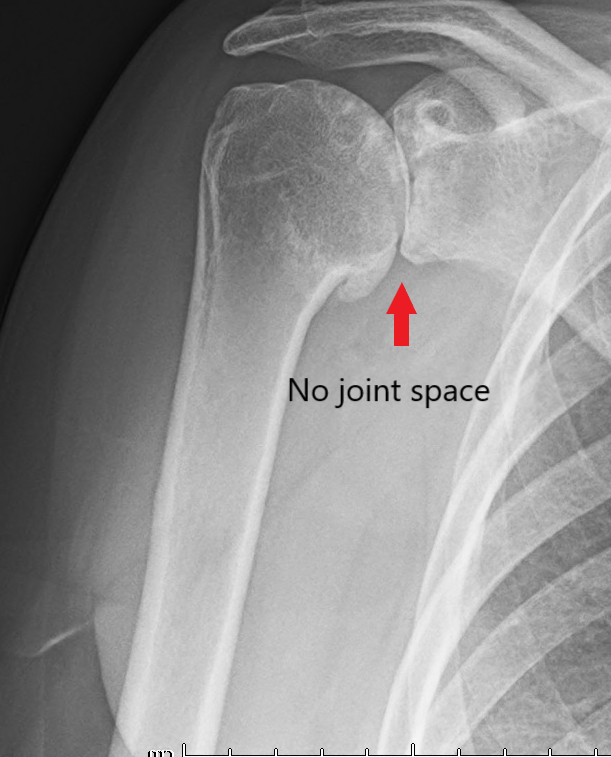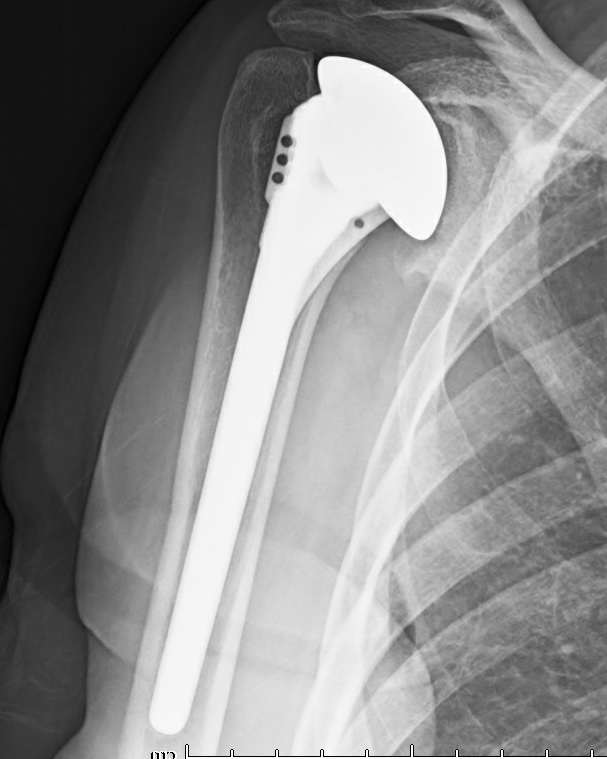Shoulder Replacement/Arthroplasty Surgery
Your Diagnosis
A shoulder replacement surgery (also called shoulder arthroplasty) is done to help people with shoulder arthritis (see picture).
What happens during Surgery?
During surgery the rough ball of the shoulder joint (humeral head) is replaced it with a smooth metal ball (see picture).
The cup is addressed in one of three ways:
1) The cup is left alone. This is usually done if the cup is smooth and concave.
2) The cup is covered with a plastic liner. Since the plastic liner has a tendency to wear out, this is usually done for people who do not to use their shoulder much.
3) The cup is biologically resurfaced (ream and run) to recreate a smooth cup out of the person’s own bone. This is usually done if the cup is rough and/or flat in a person who would like to get back to normal activities without worry of wearing out a plastic liner.
Surgery usually takes between 45 minutes to 1 hour. It is done with general anesthesia meaning the person is asleep. Usually the person will have a nerve block placed in their neck which usually makes their shoulder, arm and hand numb for 6 to 48 hours.
Because of all the steps needed to ensure a safe surgery and a safe recovery, loved ones should not expect to see the person for 4 to 6 hours after the person having surgery goes into the operating room. This is normal and to be expected.
Immediately after Surgery
The person will wake from surgery in the recovery room where they will spend 1 to 3 hours. Later they will be transferred to their room and typically will spend 1 night in the hospital. The person may notice that they cannot feel or move their arm, hand and fingers. This is because of the nerve block and is normal.
After spending 1 to 3 hours in the recovery room the person is usually moved up to their room. Most people will benefit from a continuous passive motion machine (CPM). The nurse will hook the person up to the machine and teach the person how to use the machine. The person can start or stop the machine whenever they like. The person should use this machine as often as possible.
A person may have questions following surgery. Many of these frequently asked questions about surgery can be answered here.
What to expect after Surgery: week 0 through week 6 (Phase One)
- Pain: It is normal for a person to experience moderate to severe pain for the first few days after surgery. A person will be given pain pills to take for the first 5 days after surgery. After that, only Tylenol is recommended (only if the person’s primary doctor says it is safe for them). Pain from the surgery should decrease by as much as half with each passing day. Pain is usually improved with the stretches that are taught. If a person wakes up with pain in the middle of the night, they should do their stretching exercises, as stretching usually makes the pain better.
- Therapy: After waking up from surgery and being brought up to their room, a therapist will visit the person to teach the person the 40/140 Therapy Program. This therapy program involves stretching the shoulder that had the surgery with the help of the other arm. The person will be taught 2 stretches. Each stretch should be done 5 times in row. Each set must be done 5 times a day. This means a total of 50 stretches per day.If a person’s shoulder is too sore to be stretched, it’s very important that they communicate this to their provider and therapist. Every day that passes that a person does not achieve their range-of-motion goals, makes it extra difficult to get back on track.
- Precautions: For the first 6 weeks after surgery, a person may do Passive Range-of-Motion only. It is extremely important the person does not actively use their arm (Active Range-of-Motion), and keep it completely relaxed for the first 6 weeks after surgery. This is because the only way to do the shoulder replacement surgery is to cut through one of the rotator cuff tendons (the subscapularis tendon, the rotator cuff tendon in the front). If a person actively uses their shoulder before this tendon is fully healed, the surgical repair could pull apart, and the person may need another surgery. There is no “minimally invasive” way to do a shoulder replacement. Although a person will not be permitted to move their arm/shoulder away from their body, they will still be able to move their elbows and wrists. This means they can still do easy activities like type, write, cut their food, feed themselves, wash their face, etc.
The only form of exercise a person should do at this point, is: 1) walk uphill on a paved, even road with their arm in a sling OR 2) ride a stationary bike with their arm in a sling and not holding on to the handle bar.
- Work: Nothing should get in the way of the shoulder stretches after surgery. If a person wants to go back to work right away they must find the time while at work to do the stretches. They also must follow the above mentioned precautions. If the person can afford not to go back to work right away they will receive a doctor’s note for their employer.
What to expect after Surgery: week 6 through week 12 (Phase Two)
- Pain: It is expected that there will be pain with movement of the shoulder. Pain should be much less than immediately after surgery. Most people are comfortable if they are resting.
- Therapy: Starting on week 6, the previous stretches will be stopped. The person will begin 4 Quadrant Stretching. They will also begin the Early Strengthening Program.
- Precautions: Starting on week 6 all precautions are lifted. The person may begin to use their arm. The level of activity will be guided by their pain. If the pain is tolerable they can continue their activity. If the pain is too much they should back off the activity.
The shoulder and arm will be weak at this point since the person has not used the arm for the last 6 weeks. As such, the person should use common sense when returning to activities. For example, if the person wants to play golf they should start out at the driving range first to see how the shoulder responds- not jump into 18 holes with their friends. Or, if the person wants to swim, they should start out in the shallow end to see how the arm will respond- not the deep end. - Work: Work should not interfere with the therapy programs. If a person wants to return to work during this period they must find time to stretch and strengthen.
Most people who have jobs that require physical labor are not ready to return to work at the 6 week mark. Some may be ready to go back around weeks 8-10. It’s unlikely that a person who has a highly physical job will go back to full duty at this time.
What to expect after Surgery: week 12 through 1 year and beyond (Phase Three)
- Pain: The pain will continue to decrease over the year. It is normal to still have pain once in a while.
- Therapy: After week 12 most people will begin to decrease the number of stretches and strengthening exercises they do. They also begin to return to normal activities. Their function will gradually improve over the year.
- Precautions: Usually by the 12 week mark, a person is doing about 80% of the kind of activity and exercise they were doing prior to surgery. It is important to note, that most people continue to improve for at least 1 to 1 1/2 years after their surgery.
- Work: Most people have returned to work.

Normal Shoulder

Shoulder with Arthritis
